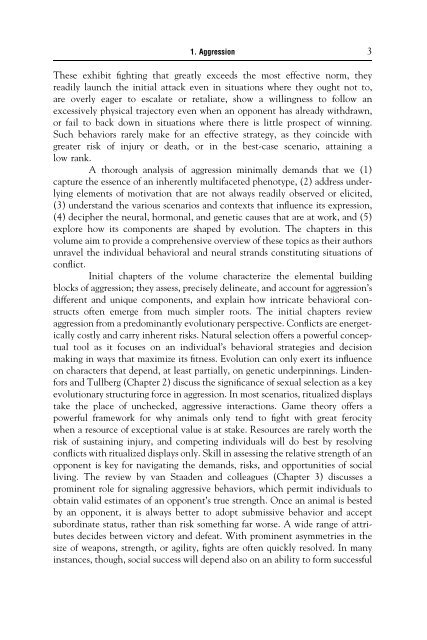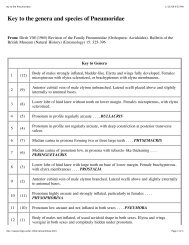- Page 2 and 3: Aggression Volume 75
- Page 4 and 5: Volume 75 Aggression Edited by Robe
- Page 6 and 7: Contents Contributors ix 1 Aggressi
- Page 8 and 9: Contents vii Acknowledgments 140 Re
- Page 10 and 11: Contributors Numbers in parentheses
- Page 12 and 13: 1 Aggression Robert Huber* and Patr
- Page 16 and 17: 1. Aggression 5 destruction, humans
- Page 18 and 19: 2 Evolutionary Aspects of Aggressio
- Page 20 and 21: 2. Evolutionary Aspects of Aggressi
- Page 22 and 23: 2. Evolutionary Aspects of Aggressi
- Page 24 and 25: 2. Evolutionary Aspects of Aggressi
- Page 26 and 27: 2. Evolutionary Aspects of Aggressi
- Page 28 and 29: 2. Evolutionary Aspects of Aggressi
- Page 30 and 31: 2. Evolutionary Aspects of Aggressi
- Page 32 and 33: References 2. Evolutionary Aspects
- Page 34 and 35: 3 Signaling Aggression Moira J. van
- Page 36 and 37: 3. Signaling Aggression 25 Such agg
- Page 38 and 39: 3. Signaling Aggression 27 Table 3.
- Page 40 and 41: 3. Signaling Aggression 29 Performa
- Page 42 and 43: 3. Signaling Aggression 31 II. BIRD
- Page 44 and 45: 3. Signaling Aggression 33 the evid
- Page 46 and 47: 3. Signaling Aggression 35 The use
- Page 48 and 49: 3. Signaling Aggression 37 predict
- Page 50 and 51: 3. Signaling Aggression 39 A Darkne
- Page 52 and 53: A B Escalation Miscellaneous visual
- Page 54 and 55: 3. Signaling Aggression 43 0.1 Huma
- Page 56 and 57: 3. Signaling Aggression 45 Alexande
- Page 58 and 59: 3. Signaling Aggression 47 Hughes,
- Page 60 and 61: 3. Signaling Aggression 49 Searcy,
- Page 62 and 63: 4 Self-Structuring Properties of Do
- Page 64 and 65:
4. Self-Structuring Properties of D
- Page 66 and 67:
4. Self-Structuring Properties of D
- Page 68 and 69:
One common type of study of fish ex
- Page 70 and 71:
4. Self-Structuring Properties of D
- Page 72 and 73:
4. Self-Structuring Properties of D
- Page 74 and 75:
4. Self-Structuring Properties of D
- Page 76 and 77:
4. Self-Structuring Properties of D
- Page 78 and 79:
4. Self-Structuring Properties of D
- Page 80 and 81:
4. Self-Structuring Properties of D
- Page 82 and 83:
4. Self-Structuring Properties of D
- Page 84 and 85:
4. Self-Structuring Properties of D
- Page 86 and 87:
4. Self-Structuring Properties of D
- Page 88 and 89:
4. Self-Structuring Properties of D
- Page 90 and 91:
4. Self-Structuring Properties of D
- Page 92 and 93:
4. Self-Structuring Properties of D
- Page 94 and 95:
5 Neurogenomic Mechanisms of Aggres
- Page 96 and 97:
5. Neurogenomic Mechanisms of Aggre
- Page 98 and 99:
5. Neurogenomic Mechanisms of Aggre
- Page 100 and 101:
5. Neurogenomic Mechanisms of Aggre
- Page 102 and 103:
C. Aggression outside the breeding
- Page 104 and 105:
5. Neurogenomic Mechanisms of Aggre
- Page 106 and 107:
5. Neurogenomic Mechanisms of Aggre
- Page 108 and 109:
5. Neurogenomic Mechanisms of Aggre
- Page 110 and 111:
5. Neurogenomic Mechanisms of Aggre
- Page 112 and 113:
5. Neurogenomic Mechanisms of Aggre
- Page 114 and 115:
5. Neurogenomic Mechanisms of Aggre
- Page 116 and 117:
5. Neurogenomic Mechanisms of Aggre
- Page 118 and 119:
5. Neurogenomic Mechanisms of Aggre
- Page 120 and 121:
5. Neurogenomic Mechanisms of Aggre
- Page 122 and 123:
5. Neurogenomic Mechanisms of Aggre
- Page 124 and 125:
5. Neurogenomic Mechanisms of Aggre
- Page 126 and 127:
5. Neurogenomic Mechanisms of Aggre
- Page 128 and 129:
5. Neurogenomic Mechanisms of Aggre
- Page 130 and 131:
5. Neurogenomic Mechanisms of Aggre
- Page 132 and 133:
6 Genetics of Aggression in Voles K
- Page 134 and 135:
6. Genetics of Aggression in Voles
- Page 136 and 137:
6. Genetics of Aggression in Voles
- Page 138 and 139:
6. Genetics of Aggression in Voles
- Page 140 and 141:
6. Genetics of Aggression in Voles
- Page 142 and 143:
6. Genetics of Aggression in Voles
- Page 144 and 145:
6. Genetics of Aggression in Voles
- Page 146 and 147:
6. Genetics of Aggression in Voles
- Page 148 and 149:
6. Genetics of Aggression in Voles
- Page 150 and 151:
6. Genetics of Aggression in Voles
- Page 152 and 153:
6. Genetics of Aggression in Voles
- Page 154 and 155:
6. Genetics of Aggression in Voles
- Page 156 and 157:
6. Genetics of Aggression in Voles
- Page 158 and 159:
6. Genetics of Aggression in Voles
- Page 160 and 161:
6. Genetics of Aggression in Voles
- Page 162 and 163:
7 The Neurochemistry of Human Aggre
- Page 164 and 165:
7. The Neurochemistry of Human Aggr
- Page 166 and 167:
7. The Neurochemistry of Human Aggr
- Page 168 and 169:
7. The Neurochemistry of Human Aggr
- Page 170 and 171:
7. The Neurochemistry of Human Aggr
- Page 172 and 173:
7. The Neurochemistry of Human Aggr
- Page 174 and 175:
7. The Neurochemistry of Human Aggr
- Page 176 and 177:
7. The Neurochemistry of Human Aggr
- Page 178 and 179:
7. The Neurochemistry of Human Aggr
- Page 180 and 181:
7. The Neurochemistry of Human Aggr
- Page 182 and 183:
8 Human Aggression Across the Lifes
- Page 184 and 185:
8. Human Aggression Across the Life
- Page 186 and 187:
8. Human Aggression Across the Life
- Page 188 and 189:
Table 8.2. Effect Sizes (Correlatio
- Page 190 and 191:
Missouri twins (Hudziak et al., 200
- Page 192 and 193:
Ad-Health (Cho et al., 2006) Colora
- Page 194 and 195:
items such as: “some people think
- Page 196 and 197:
8. Human Aggression Across the Life
- Page 198 and 199:
8. Human Aggression Across the Life
- Page 200 and 201:
8. Human Aggression Across the Life
- Page 202 and 203:
8. Human Aggression Across the Life
- Page 204 and 205:
8. Human Aggression Across the Life
- Page 206 and 207:
8. Human Aggression Across the Life
- Page 208 and 209:
8. Human Aggression Across the Life
- Page 210 and 211:
8. Human Aggression Across the Life
- Page 212 and 213:
8. Human Aggression Across the Life
- Page 214 and 215:
8. Human Aggression Across the Life
- Page 216 and 217:
8. Human Aggression Across the Life
- Page 218 and 219:
8. Human Aggression Across the Life
- Page 220 and 221:
8. Human Aggression Across the Life
- Page 222 and 223:
8. Human Aggression Across the Life
- Page 224 and 225:
8. Human Aggression Across the Life
- Page 226 and 227:
9 Perinatal Risk Factors in the Dev
- Page 228 and 229:
9. Perinatal Factors in the Develop
- Page 230 and 231:
1. Amygdala 9. Perinatal Factors in
- Page 232 and 233:
9. Perinatal Factors in the Develop
- Page 234 and 235:
9. Perinatal Factors in the Develop
- Page 236 and 237:
9. Perinatal Factors in the Develop
- Page 238 and 239:
9. Perinatal Factors in the Develop
- Page 240 and 241:
9. Perinatal Factors in the Develop
- Page 242 and 243:
9. Perinatal Factors in the Develop
- Page 244 and 245:
9. Perinatal Factors in the Develop
- Page 246 and 247:
9. Perinatal Factors in the Develop
- Page 248 and 249:
9. Perinatal Factors in the Develop
- Page 250 and 251:
9. Perinatal Factors in the Develop
- Page 252 and 253:
9. Perinatal Factors in the Develop
- Page 254 and 255:
9. Perinatal Factors in the Develop
- Page 256 and 257:
9. Perinatal Factors in the Develop
- Page 258 and 259:
9. Perinatal Factors in the Develop
- Page 260 and 261:
9. Perinatal Factors in the Develop
- Page 262 and 263:
9. Perinatal Factors in the Develop
- Page 264 and 265:
9. Perinatal Factors in the Develop
- Page 266 and 267:
10 Neurocriminology Benjamin R. Nor
- Page 268 and 269:
10. Neurocriminology 257 evident in
- Page 270 and 271:
10. Neurocriminology 259 Another qu
- Page 272 and 273:
10. Neurocriminology 261 frontal co
- Page 274 and 275:
10. Neurocriminology 263 found to h
- Page 276 and 277:
10. Neurocriminology 265 low attent
- Page 278 and 279:
10. Neurocriminology 267 self-repor
- Page 280 and 281:
10. Neurocriminology 269 MAO-A acti
- Page 282 and 283:
10. Neurocriminology 271 birth comp
- Page 284 and 285:
10. Neurocriminology 273 We have no
- Page 286 and 287:
10. Neurocriminology 275 Alexander,
- Page 288 and 289:
10. Neurocriminology 277 Evseef, G.
- Page 290 and 291:
10. Neurocriminology 279 Langevin,
- Page 292 and 293:
10. Neurocriminology 281 Raine, A.
- Page 294 and 295:
10. Neurocriminology 283 Streissgut
- Page 296 and 297:
Index Adoption study, human aggress
- Page 298 and 299:
Index 287 receptors, 132-133 regula
- Page 300 and 301:
Index 289 N Neural circuits aggress
- Page 302 and 303:
Index 291 R Reactive and Proactive
- Page 304 and 305:
Index 293 forms of, 191-193 G x E i
- Page 306 and 307:
0.1 Human (Homo sapien) Other prima



